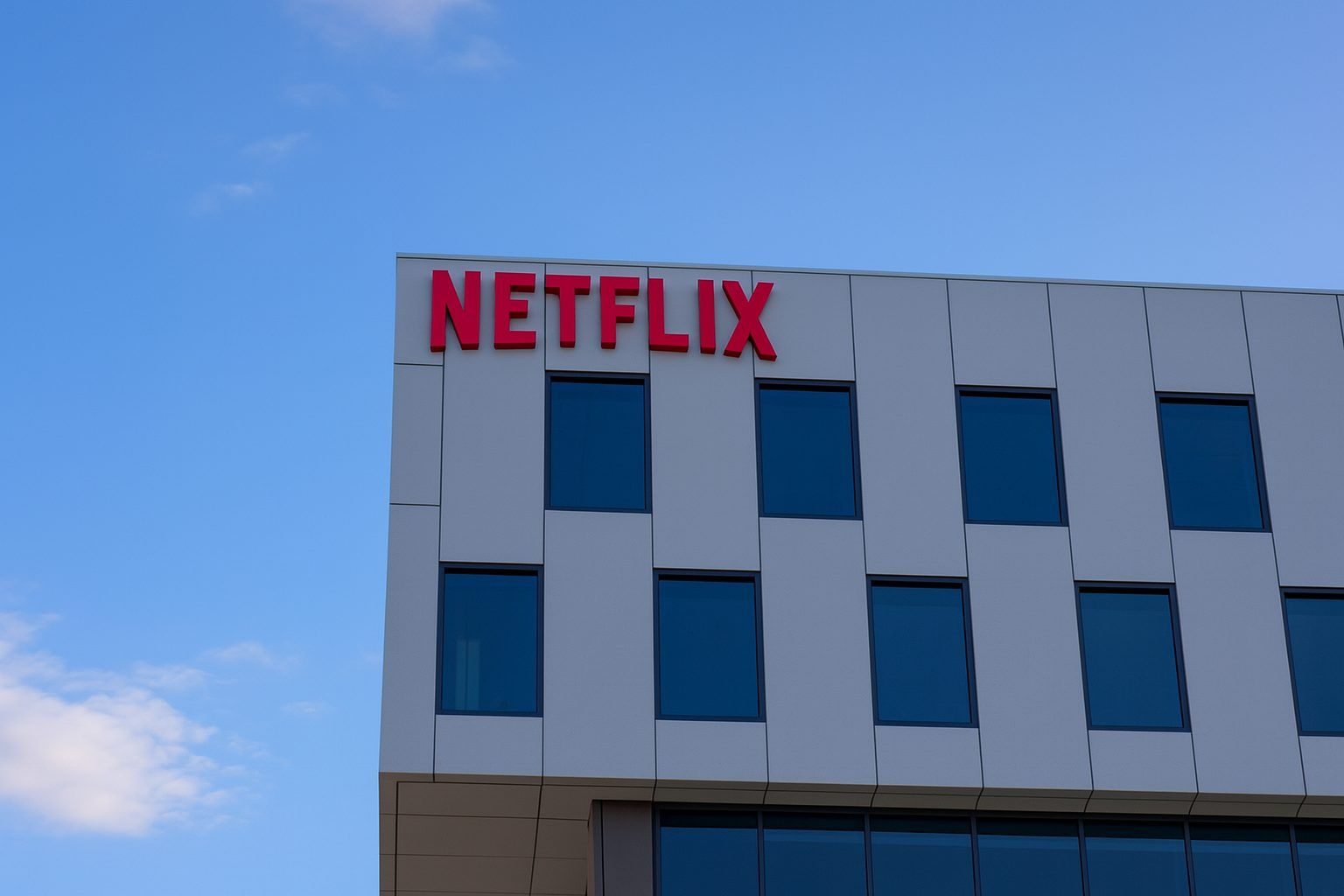As of early afternoon on Monday, November 24, 2025, Netflix stock (NASDAQ: NFLX) is trading around $104–105 per share, essentially flat on the day following last week’s high‑profile 10‑for‑1 stock split. [1]
Behind that calm headline, however, investors are juggling three big storylines:
- A post‑split pullback after a powerful multi‑year rally
- A Q3 earnings miss driven by a one‑time tax expense, masking strong underlying growth
- A potentially transformative bid for Warner Bros. Discovery (WBD) that could reshape the media landscape. [2]
Here’s what you need to know about NFLX stock today.
NFLX Stock Price Today: Split Hangover After a Big Run
- Current price: about $104.4 per share intraday on Nov. 24, 2025
- Day move: roughly flat, within a tight range around $103–105 [3]
- Post‑split action: Netflix executed a 10‑for‑1 stock split last week, cutting the share price from around $1,100 to roughly $110 to make the stock more accessible to employees and retail investors. [4]
- Since that split, shares have slipped roughly 6%, closing last Friday at $104.31, and are now about 22% below their July all‑time high near $134 (split‑adjusted). [5]
Zooming out:
- Over the past 12 months, Netflix stock is still up about 40%, handily beating the S&P 500’s gain of roughly 13% over the same period. [6]
- Year‑to‑date, NFLX remains firmly positive, even after the recent pullback. [7]
In short, NFLX has moved from a “high‑flyer” to a still‑expensive but more approachable growth stock, with sentiment cooling from euphoric to cautiously optimistic.
The 10‑for‑1 Stock Split: Cosmetic Move, Real Psychology
Fundamentally, a stock split does not change Netflix’s earnings power or valuation. Market cap stays the same; investors simply own more shares at a lower price.
So why does it matter?
- The split lowers the per‑share price, making Netflix feel more “buyable” to smaller investors and helping employee equity programs. [8]
- Options markets are already signaling moderately bullish expectations:
- One recent options analysis suggests derivatives are pricing in roughly 7–8% upside from post‑split levels into early 2026, with certain February 2026 contracts implying potential moves toward the $118 area. [9]
That said, options also imply meaningful downside risk, and technical analysts note that Netflix has broken below some support levels, opening the door to further volatility (more on that below). [10]
Q3 2025: Tax Hit Masks Strong Core Growth
Netflix’s Q3 2025 results, released in October, are still driving much of today’s narrative.
Key headline numbers:
- Revenue: $11.51 billion, up about 17% year over year, in line with guidance. [11]
- Operating income: ~$3.2–3.25 billion, up around 12% YoY but below the company’s earlier guidance range. [12]
- Operating margin:~28%, versus guidance around 31.5% and 30% in the prior year. [13]
- Free cash flow (FCF): about $2.6–2.7 billion, up more than 20% YoY and ahead of internal targets. [14]
- Paid net additions:+8.8 million subscribers in the quarter, a nearly 50% improvement versus the same quarter last year. [15]
The big negative surprise:
Netflix missed its margin guidance largely due to an unexpected tax provision in Brazil, which management says clipped about 3 percentage points off operating margin. Without that one‑off charge, Netflix claims it would have met or exceeded its margin goals. [16]
For long‑term investors, that distinction matters. Revenue and user growth were strong; the miss came from a one‑time legal/tax issue rather than a demand problem.
Netflix also raised its full‑year 2025 free‑cash‑flow outlook to roughly $6.5 billion, up from prior guidance of “greater than $5 billion,” underscoring improving cash generation even as it invests in content, ads, and new initiatives. [17]
From Subscribers to Profitability: Netflix’s New Scoreboard
Starting in 2025, Netflix stopped reporting quarterly subscriber numbers, a major philosophical shift after years of Wall Street obsession with net adds. Management now wants investors to focus on revenue growth, margins, free cash flow, and engagement. [18]
Behind that change is a simple idea:
A smaller, more engaged, higher‑paying audience can be more valuable than a larger, low‑ARPU one.
Three structural growth pillars are doing the heavy lifting:
1. Password‑Sharing Crackdown
Netflix’s password‑sharing crackdown – initially unpopular with many users – has turned into one of the company’s biggest growth levers:
- Third‑party data suggests the crackdown converted a meaningful chunk of an estimated 100 million “freeloader” households into paying customers, adding roughly 50 million subscribers since mid‑2023 and boosting revenue and ARPU. [19]
- Earlier analyses showed daily sign‑ups more than doubling versus prior trends when the crackdown rolled out, and the ratio of sign‑ups to cancellations improving by over 25%. [20]
- One MarketWatch analysis estimated that since the crackdown began, Netflix’s total subscriber base climbed nearly 27% to above 300 million globally. [21]
Other streamers – including Disney+ and Max – have followed Netflix’s lead, signaling a structural shift in the streaming business away from “free riders.” [22]
2. Ad‑Supported Tier
Ads are quickly moving from “side experiment” to core profit driver:
- Netflix reported its best ad‑sales quarter ever in Q3 2025 and has said it is on track to more than double ad revenue to nearly $3 billion in 2025. [23]
- The ad tier now represents around 40% of new sign‑ups in markets where it is available, and ad‑tier memberships grew roughly 70% quarter‑over‑quarter in Q3. [24]
Ads give Netflix a powerful ARPU lever: the company can keep subscription prices competitive while layering on fast‑growing advertising income.
3. Live Events, Sports, and Gaming
Netflix is also pushing into live programming and interactive entertainment:
- Events like the Canelo vs. Crawford boxing match delivered record engagement and showcased Netflix’s ability to handle large‑scale live streams. [25]
- Live sports, unscripted reality competitions, and live comedy specials are becoming a key engagement pillar, giving Netflix “appointment viewing” it historically lacked. [26]
- The company continues to invest in gaming and consumer products, treating popular IP such as its hit animated film KPop Demon Hunters as franchises that can span films, series, games, and merchandise. [27]
Taken together, these initiatives aim to diversify growth away from pure subscriber counts, and towards a richer blend of pricing power, ads, engagement, and IP monetization.
The Warner Bros. Discovery Bid: Big Swing, Big Questions
The newest and most dramatic storyline for NFLX stock is Netflix’s participation in the bidding war for Warner Bros. Discovery (WBD).
Over the past week:
- Netflix, Paramount Skydance, and Comcast have all submitted non‑binding bids to acquire all or parts of Warner Bros. Discovery, according to multiple reports. [28]
- Netflix’s bid is said to focus on studio and streaming assets – including the Warner Bros. film library, HBO, and the Max streaming service. [29]
- A Bloomberg‑reported detail that grabbed headlines: Netflix has told Warner Bros. Discovery management it would continue theatrical releases of the studio’s films if its bid succeeds, a sharp departure from Netflix’s historic streaming‑first stance. [30]
Why does this matter for NFLX stock?
- Content moat: Warner Bros.’ IP – from Harry Potter and Lord of the Rings to DC comics and HBO’s prestige series – would dramatically expand Netflix’s library and franchising opportunities. [31]
- Strategic pivot: A commitment to theatrical releases could unlock new revenue streams and marketing lift while Netflix continues to monetize via streaming and ads. [32]
- Integration and debt risk: WBD carries substantial debt, and any deal would be complex, expensive and heavily scrutinized by regulators in the U.S. and Europe. [33]
It’s early days. All bids are first‑round and non‑binding; Warner Bros. Discovery could hold out for better terms, choose a different buyer, or ultimately decide not to sell and instead proceed with a planned breakup of its studio and cable arms. [34]
For now, the WBD saga is a potential upside catalyst rather than a base‑case assumption in most analyst models.
Wall Street View: “Buy” / “Moderate Buy” With ~30% Upside
Despite recent volatility, Wall Street remains broadly positive on NFLX.
Consensus ratings & price targets
- MarketBeat:
- Consensus rating: Moderate Buy from 45 analysts
- Mix: 30 Buy, 2 Strong Buy, 12 Hold, 1 Sell
- Average 12‑month price target:$133.93, implying about 28% upside from around $104.40. [35]
- StockAnalysis:
- 32 analysts covering NFLX
- Consensus rating: Buy
- Average target:$134.13 (range: $87.50–$160.00), implying roughly 28–29% upside. [36]
- Options‑driven research from Invezz similarly cites a mean target around $136, framing potential upside of about 30–31% from today’s levels. [37]
Growth expectations
According to StockAnalysis’ aggregation of Wall Street forecasts: [38]
- Revenue 2025: ~$46.0 billion, up about 18% from 2024
- Revenue 2026: ~$51.9 billion, up another 13%
- EPS 2025: about $2.60, up 31% from 2024 (split‑adjusted)
- EPS 2026: about $3.30, another 27% increase
That puts Netflix on track for double‑digit top‑line growth and faster earnings growth, as operating leverage and ad monetization kick in.
Valuation
Using those forecasts, Netflix trades at a forward P/E in the low‑30s, notably above the broader market but in line with historically premium growth stocks delivering mid‑teens revenue growth and rising margins. [39]
Technical and Sentiment Check: Bulls vs. Bears
Not everyone is convinced Netflix’s recent pullback is over.
- A technical analysis piece from FXLeaders notes that NFLX shares are down about 22–23% from their summer peak and roughly 22.6% over the past six months, with the stock breaking below key support levels. [40]
- That analysis warns the stock could fall another ~15% from current prices if selling pressure continues, pointing to potential support zones near $89, and, in a more bearish scenario, the low $70s or even $60 region. [41]
On the other hand:
- Options data shows a put‑to‑call ratio below 1, implying more bullish than bearish positioning among derivatives traders. [42]
- Institutional interest remains active: a recent filing highlights Liontrust Investment Partners LLP adding 244,233 NFLX shares, while hundreds of other funds have either added or trimmed positions in recent quarters. [43]
The result is a mixed near‑term picture: technicals leaning cautious, but fundamentals and analyst expectations still skewed positively.
Key Risks for NFLX Stock in Late 2025
Before drawing any conclusions, investors should weigh the main risks hanging over Netflix:
- Macro and ad‑market sensitivity
A meaningful slice of incremental growth now comes from advertising, which is more cyclical than subscription revenue and vulnerable to economic slowdowns. [44] - Regulatory and deal risk around WBD
Any acquisition of Warner Bros. Discovery – by Netflix or a rival – will face intense antitrust and political scrutiny, especially given the combined market share in streaming and theatrical distribution. [45] - Content cost inflation
Even with better discipline, high‑end scripted and live content remains expensive. Netflix continues to balance spending with margin goals in a still‑competitive streaming landscape. [46] - Execution on new verticals
Live sports, gaming, and consumer products all require new capabilities and partnerships. There is no guarantee that Netflix will achieve the same dominance in these areas that it has in on‑demand streaming. [47]
What to Watch for NFLX This Week
For traders and long‑term investors following NFLX over the coming days, a few near‑term catalysts stand out:
- Updates on the Warner Bros. Discovery sale process – any leaks about preferred bidders, regulatory pushback, or valuations could move not just WBD, but Netflix and key competitors. [48]
- Analyst revisions – further price‑target cuts or upgrades after Q3 and the stock split (JPMorgan recently trimmed its target to $124 while maintaining a neutral stance). [49]
- Holiday content performance – Netflix’s Thanksgiving‑week slate, which includes big‑name series and films, should support engagement at a time when investors are watching churn and time‑spent metrics closely. [50]
Bottom Line: NFLX Stock Today
On November 24, 2025, Netflix stock is in a consolidation phase:
- The company is delivering strong revenue and earnings growth with expanding free cash flow, powered by its password‑sharing crackdown, ad‑supported tier, and new content formats. [51]
- Wall Street still sees high‑teens revenue growth and ~30% earnings growth, with consensus upside of roughly 25–30% over the next 12 months. [52]
- At the same time, the stock faces a post‑split hangover, technical headwinds, and deal‑risk noise from the Warner Bros. Discovery bidding war. [53]
For growth‑oriented investors, NFLX remains a high‑quality but higher‑risk streaming and media name, now priced in a way that is more accessible but still demanding execution.
As always, this article is for informational purposes only and does not constitute financial advice. Anyone considering Netflix stock should evaluate their own risk tolerance, time horizon, and portfolio needs, and consider consulting a qualified financial adviser.
References
1. www.marketbeat.com, 2. moneymorning.com, 3. stockanalysis.com, 4. moneymorning.com, 5. moneymorning.com, 6. markets.financialcontent.com, 7. markets.financialcontent.com, 8. cryptorank.io, 9. cryptorank.io, 10. www.fxleaders.com, 11. vitrina.ai, 12. static.poder360.com.br, 13. static.poder360.com.br, 14. vitrina.ai, 15. vitrina.ai, 16. static.poder360.com.br, 17. vitrina.ai, 18. www.home.saxo, 19. www.justanotherpm.com, 20. www.antenna.live, 21. www.marketwatch.com, 22. www.businessinsider.com, 23. cryptorank.io, 24. vitrina.ai, 25. vitrina.ai, 26. vitrina.ai, 27. vitrina.ai, 28. www.reuters.com, 29. www.reuters.com, 30. www.reuters.com, 31. www.reuters.com, 32. www.reuters.com, 33. www.reuters.com, 34. www.reuters.com, 35. www.marketbeat.com, 36. stockanalysis.com, 37. cryptorank.io, 38. stockanalysis.com, 39. stockanalysis.com, 40. www.fxleaders.com, 41. www.fxleaders.com, 42. cryptorank.io, 43. www.quiverquant.com, 44. cryptorank.io, 45. www.reuters.com, 46. vitrina.ai, 47. vitrina.ai, 48. www.reuters.com, 49. www.marketbeat.com, 50. www.netflix.com, 51. vitrina.ai, 52. stockanalysis.com, 53. moneymorning.com







